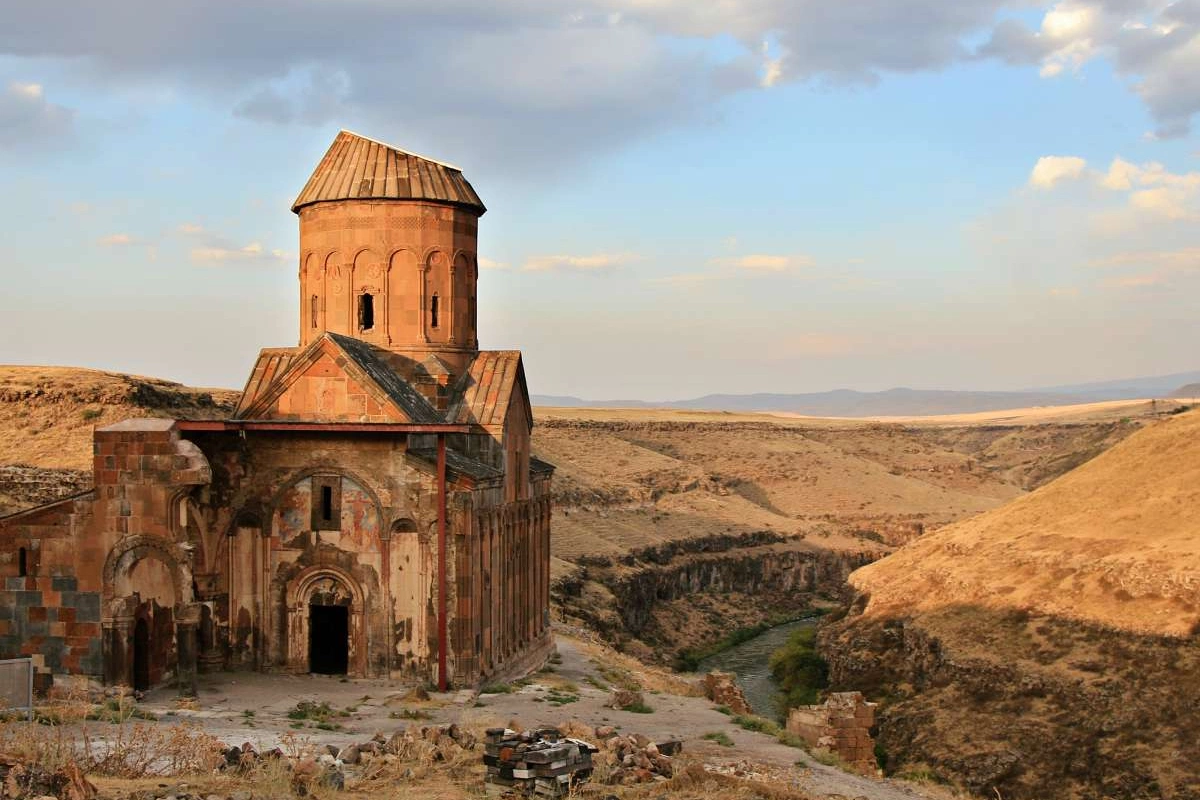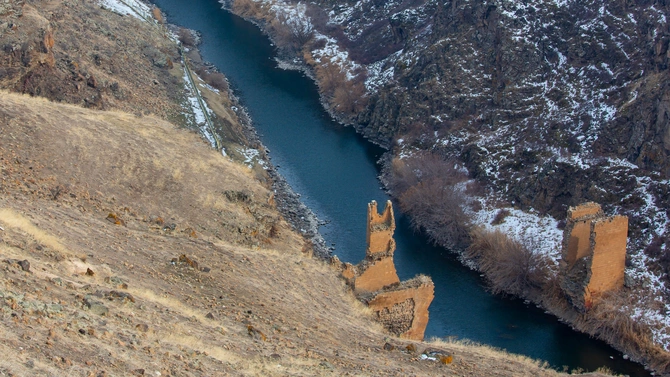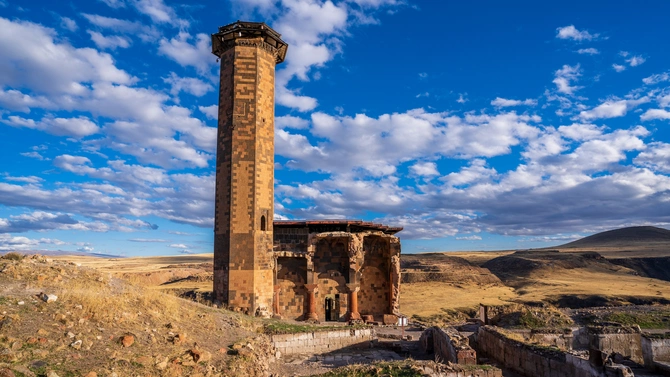
Ani: an Ancient Ghost City with 21st-Century Implications
Image: Olga Savina/Shutterstock
Hot on the heels of Armenia’s highly symbolic dispatch of aid to Turkey, the Armenian Foreign Minister, Ararat Mirzoyan, made a highly significant official visit to Ankara on February 15. Beyond the diplomatic dance lies the important goal of reopening the border between the two countries, which has been closed since 1993. That the border could reopen relatively easily was demonstrated earlier in the week when, on February 11, the Alican/Magara checkpoint (on the Echmiadzin-Dogubayazit route) was briefly sanctioned to expedite aid trucks taking supplies to the earthquake zone. One of the last times the border opened in the past 35 years was taking aid in the opposite direction after the 1988 earthquake that devastated northern Armenia.
Any timetable for the full opening of that and other border posts has yet to be fully confirmed. At a press conference, the one concrete announcement made was more symbolic: plans to rebuild a medieval bridge at Ani. On the face of it, doing up a historic monument is likely to strike many observers as a curiously meaningless cop-out. After all, politicians making a daring geopolitical step always need to have at least one or two easily achievable fall-backs up their sleeves in case the more substantive issues fail to be resolved.
However, from a regional perspective, the Ani Bridge is much more meaningful than just ‘any old’ medieval cultural reconstruction.
The shattered 9th-century bridge in question – of which just the support stumps remain - carried one of the many branches of the classic ‘Silk Route’ across the Arpachai/Akhurian River, which nowadays forms the northwestern part of Armenia’s border with Turkey. Today it’s hard to imagine this site as a busy commercial hub – it’s a decidedly remote, barely populated spot some 45km from Kars along a long straight road which passes just a handful of tiny hamlets.

Things were very different a millennium ago. Originally, this “Silk Road Bridge” was a two-level structure with heavy caravans transporting goods crossing on the lower span with pedestrians walking above. On the west side of the bridge lay the city. Ani is now a complete ghost town, an eerie UNESCO-listed scattering of impressive ruins widely dotted across a bare plateau high above the river. It’s startling to discover that this wasteland was once a metropolis of around 100,000 people, one of the world’s largest cities in its day. Its first golden era was as the capital of Bagratid Armenia. King Ashot III transferred his court here in 961, transforming an already ancient fortress village into a royal citadel with sturdy walls. These were reinforced by Ashot’s successor, Smbat II, to a length of 4.5km. The city reached its economic peak in the reign of Gagik I (990-1010), during which Ani’s remarkable cathedral was built. Ani was, by this stage, the seat of the Armenian Patriarchate, and the building was given three separate entrances – one for the patriarch, one for the king and one for the common people. The cathedral was remarkable for displaying extraordinary engineering know-how using what appears to be a forerunner of Gothic design decades before similar developments in Western Europe.
Ani is also of considerable cultural importance to Turks. The Armenian city fell to the Byzantines in 1045 but was then captured by the Suljuk Turks of Alp Arslan in 1064. The cathedral was repurposed as the Victory Mosque (Fethiye Camii), and a palace complex was erected. Meanwhile, construction started on a purpose-built mosque. Finished in 1072, this is the Manuchehr Camii, a building now widely cited as “the first Turkish mosque in Anatolia” – even if Armenian builders and architects contributed to the structure, which thus has a culturally ‘blended’ appearance. It’s relatively well conserved with six vaults and a red-and-black stone interior, and since 2019 has been slated for complete renovation into a working place of worship. Meanwhile, it’s the nearest surviving ruin to the Silk Road Bridge, whose remnants are framed through the stone window arches.

The city’s control continued to swing between different empires, with a period of Georgian control followed by Kurdish emirs, then the Mongols in 1236. They decimated the city’s population, setting in a long decline that was not helped by the 1319 earthquake or the further ravages of Timur. As trade routes shifted, Ani’s raison d’etre disappeared, and the site quietly decayed.
After WWI, when former Ottoman borders were fixed in a series of conferences and treaties, Armenia had hoped to include Ani within its western frontier. With the relatively new idea of nation-states coming to the fore, Ani’s historical resonance with a celebrated period in Armenian history made the site symbolically important. However, the ‘Arpa neutral zone’ was assigned to Turkey in the 1921 Treaty of Kars, based upon which the current borderlines were eventually agreed. Since then, Yerevan has occasionally accused Turkiye of neglecting the site “in a spirit of chauvinism,” while Ankara has been quick to retort that Armenia has itself shown disdain for the ruins by setting up four quarries just across the river: the shock waves from blasting rock is hardly conducive to protecting quake-damaged ruins.
In awarding World Heritage status back in 2016, UNESCO cited Ani’s remoteness as one of the reasons for the remarkable survival of its unique character while regretting the adverse effects of “earthquakes, the harsh climate and human destruction” as well as “large amounts of new fabric introduced in a number of restoration projects” over the years.
However, in recent years Kars has been rapidly growing as a tourism destination for domestic visitors, and locals are thrilled at the possible prospects of the border at Ani opening. Even if this is initially only geopolitical tokenism, the move offers the prospect of tourism eventually encouraging Turks and Armenians to mingle and break down politically inspired barriers through real-life human contact.
Share on social media